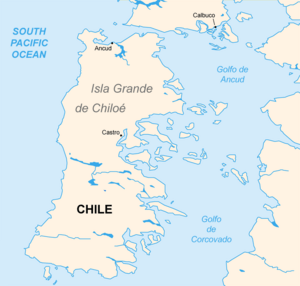Sea of Chiloé facts for kids
The Sea of Chiloé (also called Mar de Chiloé or Mar Chilote in Spanish) is a special part of the ocean near the coast of Chile. It's like a big, calm bay that is mostly separated from the huge Pacific Ocean by a large piece of land called Chiloé Island.
This sea connects to the open ocean in two main places: through the Chacao Channel in the north and the Gulf of Corcovado in the south. Many islands of the Chiloé Archipelago are found within this sea, along with other islands near the Reloncaví Sound. The edges of the Sea of Chiloé have many interesting features like narrow channels, sounds, and even deep, narrow inlets called fjords on its eastern side. South of the Gulf of Corcovado, the Sea of Chiloé changes into the Moraleda Channel.
Contents
What is a Marginal Sea?
A marginal sea is like a semi-enclosed part of a larger ocean. It's usually found along the edges of continents. These seas are often partly surrounded by islands, archipelagos (groups of islands), or peninsulas. This protection means their waters can be calmer and have different features compared to the open ocean.
How the Sea of Chiloé Formed
The Sea of Chiloé was shaped over thousands of years by powerful natural forces. During the last ice age, huge glaciers covered much of this area. As these glaciers moved, they carved out deep valleys and basins in the land. When the ice melted, these valleys filled with water, creating the channels, sounds, and fjords we see today. The land also rose and fell over time, further changing the coastline.
Geography and Features
The Sea of Chiloé is known for its unique geography. It's not just open water; it's a complex network of islands, channels, and inlets.
Chacao Channel
In the northern part, the Chacao Channel acts as a narrow gateway connecting the Sea of Chiloé to the Pacific Ocean. This channel is important for boats traveling to and from the area.
Gulf of Corcovado
To the south, the Gulf of Corcovado is a wider opening that also links the Sea of Chiloé with the Pacific. This gulf is a significant area for marine life and is part of the larger ocean system.
Islands and Archipelagos
The Sea of Chiloé is home to many islands. The main one is Chiloé Island itself, which protects the sea from the Pacific. But there are also many smaller islands that are part of the Chiloé Archipelago. These islands create a maze of waterways, making the area very interesting to explore.
Fjords and Sounds
Along the eastern coast of the Sea of Chiloé, you can find several fjords. Fjords are long, narrow inlets of the sea that are surrounded by steep cliffs. They were formed by glaciers. There are also many "sounds," which are wide sea inlets or channels that separate islands from the mainland or from other islands.
Importance of the Sea of Chiloé
The Sea of Chiloé is very important for the people and nature of the region.
Marine Life
This sea is rich in marine life. Its protected waters provide a home for many different kinds of fish, shellfish, and other sea creatures. This makes it a vital area for fishing and aquaculture (farming of aquatic animals and plants).
Local Communities
Many local communities live along the shores and on the islands of the Sea of Chiloé. Their lives are closely connected to the sea, relying on it for food, transportation, and their way of life. The sea also supports tourism, with people visiting to enjoy its natural beauty and unique culture.
Transportation
The channels and sounds of the Sea of Chiloé serve as natural highways for boats. They allow people and goods to travel between the islands and the mainland, which is essential for the region's economy and daily life.
See also
 In Spanish: Mar de Chiloé para niños
In Spanish: Mar de Chiloé para niños


